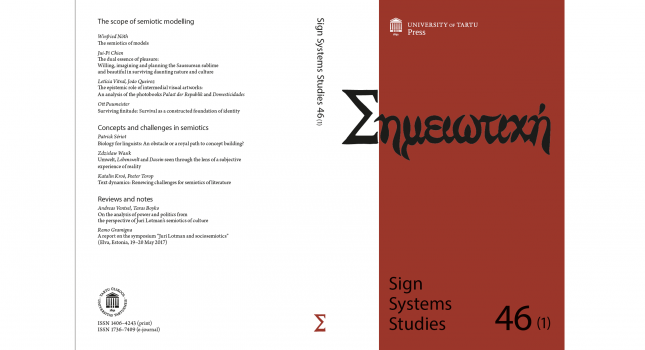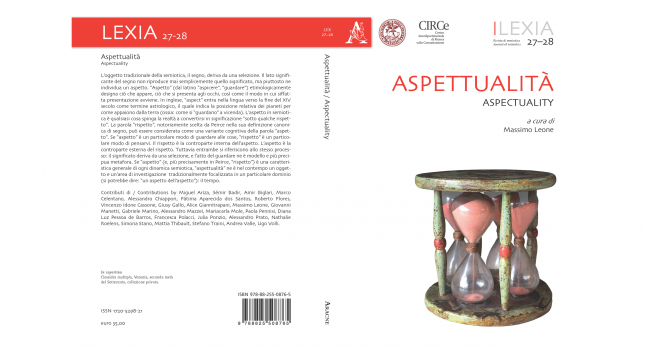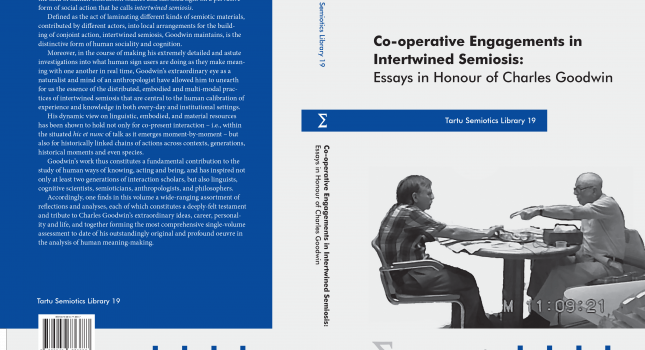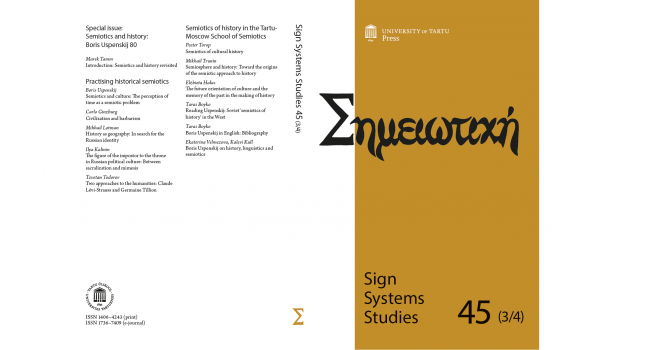In this issue (11 articles) Knowledge Is Never Just There Jesper Hoffmeyer Pages 1-5 Freedom in Captivity: Managing Zoo Animals According to the ‘Five Freedoms’ Nelly Mäekivi Pages 7-25 Object Discernment by “A Difference Which Makes a Difference” Jaime F. Cárdenas-García, Diego Romero Castro, Bruno Soria de Mesa Pages 27-40 Umwelt and Ape Language Experiments:…
Journal: SEMIOSIS Editions from 1976 to1994
SEMIOSIS 1976-1994 is posted on the website of ZKM in Karlsruhe, the numbers from 1 to 74/75/76 from the years until 1994. Semiosis. Internationale Zeitschrift für Semiotik und Ästhetik. Gegründet 1976 von Max Bense, Gerard Deledalle, Klaus Oehler und Elisabeth Walther. http://zkm.de/de/Sammlung-archive/archive/semiosis-1976-1994

Journal: Sign Systems Studies (46-1), 2018
Sign Systems Studies 46 (1), 2018 We are happy to announce the publication of the new issue of Sign Systems Studies. The online issue is available here: http://www.sss.ut.ee/ The print issue is available at https://www.tyk.ee/semiotics/00000012583 An international journal of semiotics and sign processes in culture and living nature, the journal Sign Systems Studies was established…

New issue of Lexia Journal of Semiotics, 27–28 Aspectuality
Lexia. Rivista di semiotica, 27–28 Aspettualità Lexia. Journal of Semiotics, 27–28 Aspectuality a cura di / edited by Massimo Leone Download presentation-PDF: PDF di presentazione Lexia 27-28 Lexia – Rivista di semiotica http://www.facebook.com/lexiasemiotica
New Issue: Punctum. International Journal of Semiotics Volume 3, Issue 2
New issue of Punctum-International Journal of Semiotics: Volume 3, Issue 2 (2017) – From Theory to Methodology edited by Karin Boklund-Lagopoulou and Alexandros-Ph. Lagopoulos availiable online http://punctum.gr/.

New Issue of Signs & Media (Spring Issue, 2018)
New Issue of Signs & Media (Spring Issue, 2018) We are glad to announce the publication of the Spring Issue(2018)of Signs & Media, a bilingual (English-Chinese), peer-reviewed semiotic journal. Please feel free to download the PDF Version of Signs & Media: http://www.semiotics.net.cn/index.php/zine_view/index/93 Editor’s Note (Spring Issue of Signs & Media, 2018) Semiotics is open to…

NEW BOOK IN THE SERIES TARTU SEMIOTICS LIBRARY: Co-operative Engagements in Intertwined Semiosis: Essays in Honour of Charles Goodwin
NEW BOOK IN THE SERIES TARTU SEMIOTICS LIBRARY: Co-operative Engagements in Intertwined Semiosis: Essays in Honour of Charles Goodwin Edited by Donald Favareau Vol 19 in the series Tartu Semiotics Library Available at http://www.tyk.ee/semiotics/00000012547 For almost 40 years Charles Goodwin’s pioneering work has re-shaped the field of human interaction studies and has shed light on…
New issue: Ansaq (systems) International Journal issued by Arabic department in college of arts and science – Qatar University
Ansaq (systems) International Journal issued by Arabic department in college of arts and science Qatar University Volume 1, Issue 2 (2017). Introduction: to systematic thinking. Said Yaktin «Irony» and «Discourse of Antithesis» in Nizar Qabbani’s Poetry: An analytical and Critical Study. Sami Hussein Al Qasoos The Non-belonging and the Prescribed Model Infiltration (A cultural…

New issue of Lexia Journal of Semiotics – 25-26 Virality
Lexia. Journal of Semiotics, 25–26 Virality. For an epidemiology of meaning a cura di edited by Gabriele Marino Mattia Thibault Download presentation-PDF: Lexia 25-26 – Indice e copertina Lexia – Rivista di semiotica http://www.facebook.com/lexiasemiotica

Journal: Sign Systems Studies 45 (3/4) 2017
Sign Systems Studies 45(3-4), 2017 We are happy to announce the publication of the new issue of Sign Systems Studies, this time a Special Issue: Semiotics and history: Boris Uspenskij 80, guest edited by Marek Tamm. The online issue is available here: http://www.sss.ut.ee/ The print issue will be available soon at http://www.tyk.ee/ An international journal…
